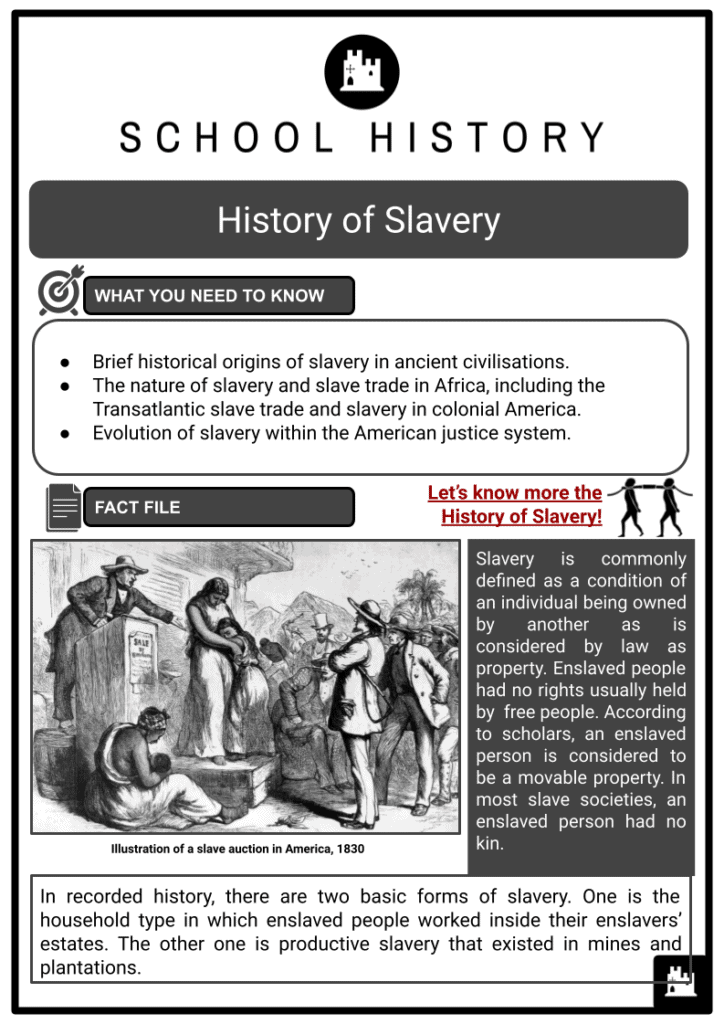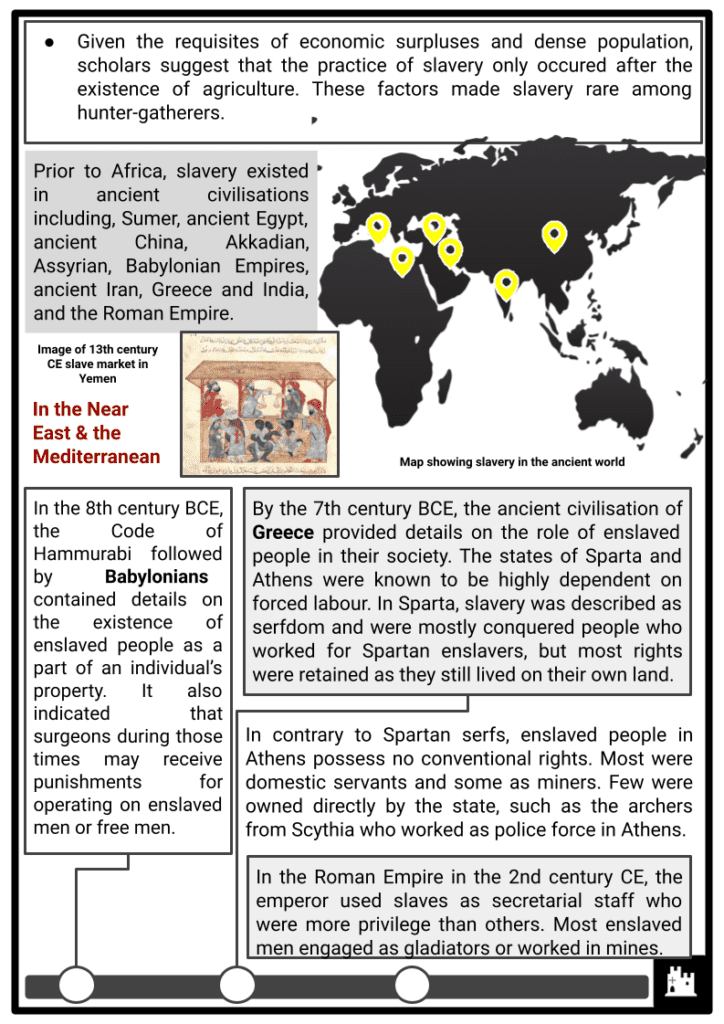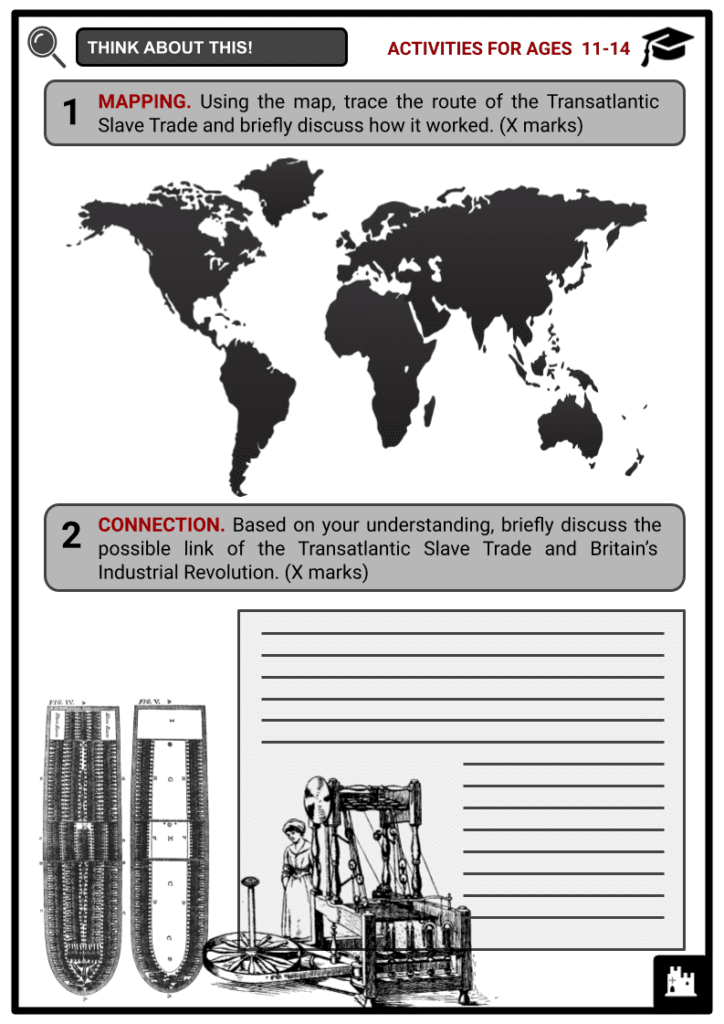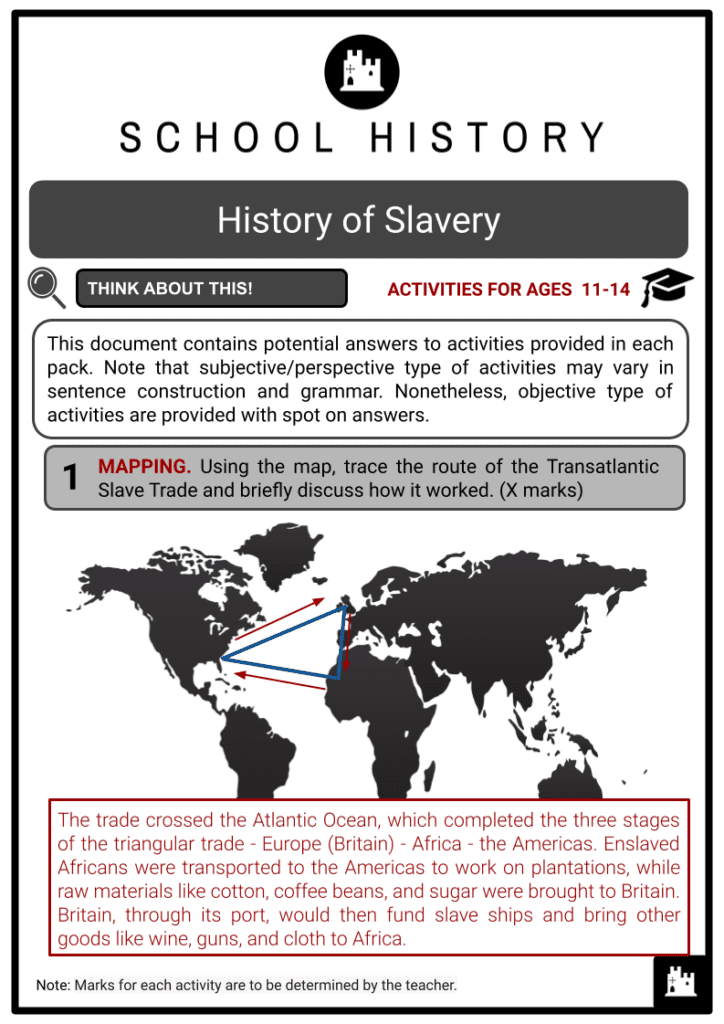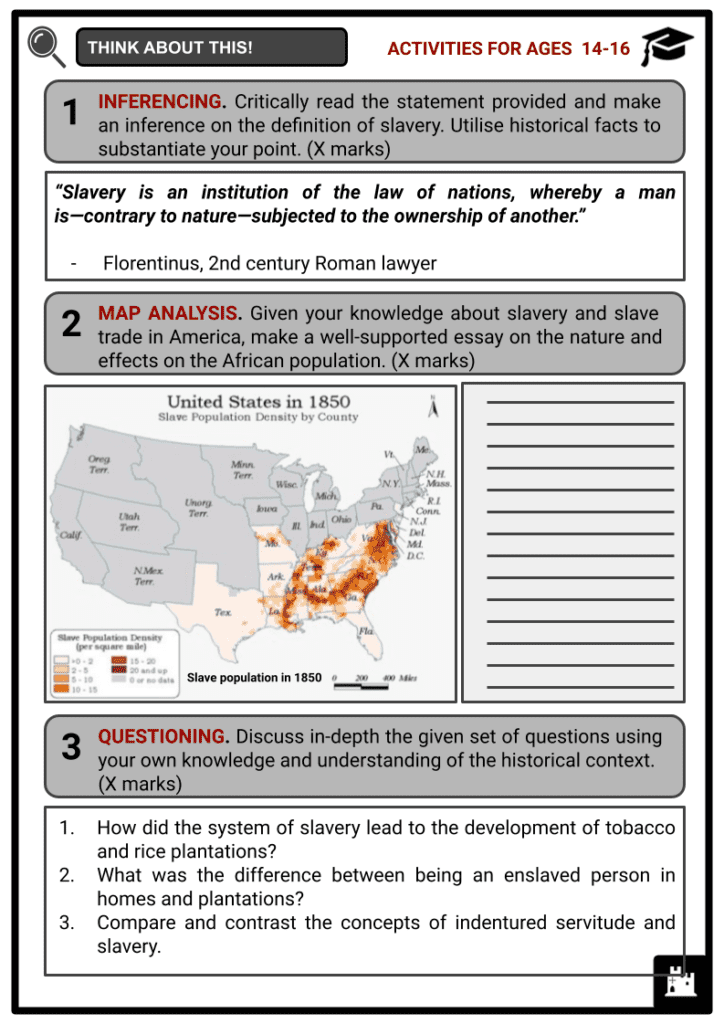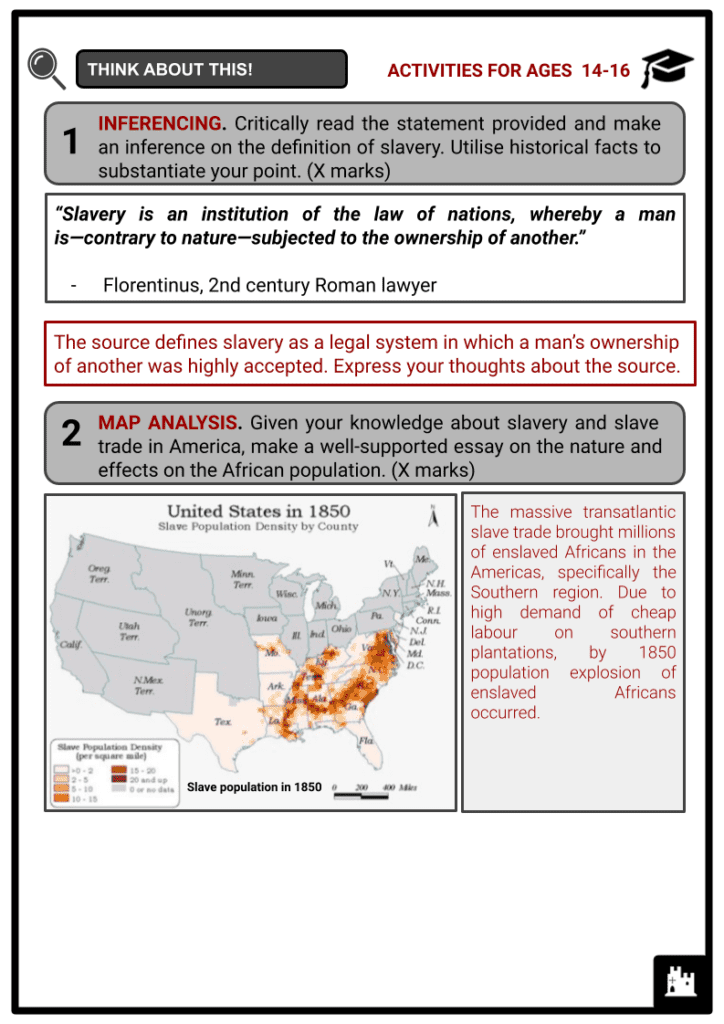Download History of Slavery Worksheets
Do you want to save dozens of hours in time? Get your evenings and weekends back? Be able to teach History of Slavery to your students?
Our worksheet bundle includes a fact file and printable worksheets and student activities. Perfect for both the classroom and homeschooling!
Table of Contents
Add a header to begin generating the table of contents
Summary
- Brief historical origins of slavery in ancient civilisations.
- The nature of slavery and slave trade in Africa, including the Transatlantic slave trade and slavery in colonial America.
- Evolution of slavery within the American justice system.
Key Facts And Information
Let’s know more about the History of Slavery!
- Slavery is commonly defined as a condition of an individual being owned by another as is considered by law as property. Enslaved people had no rights usually held by free people. According to scholars, an enslaved person is considered to be a movable property. In most slave societies, an enslaved person had no kin.
- In recorded history, there are two basic forms of slavery. One is the household type in which enslaved people worked inside their enslavers’ estates. The other one is productive slavery that existed in mines and plantations.
- Given the requisites of economic surpluses and dense population, scholars suggest that the practice of slavery only occurred after the existence of agriculture. These factors made slavery rare among hunter-gatherers.
- Prior to Africa, slavery existed in ancient civilisations including, Sumer, ancient Egypt, ancient China, Akkadian, Assyrian, Babylonian Empires, ancient Iran, Greece and India, and the Roman Empire.
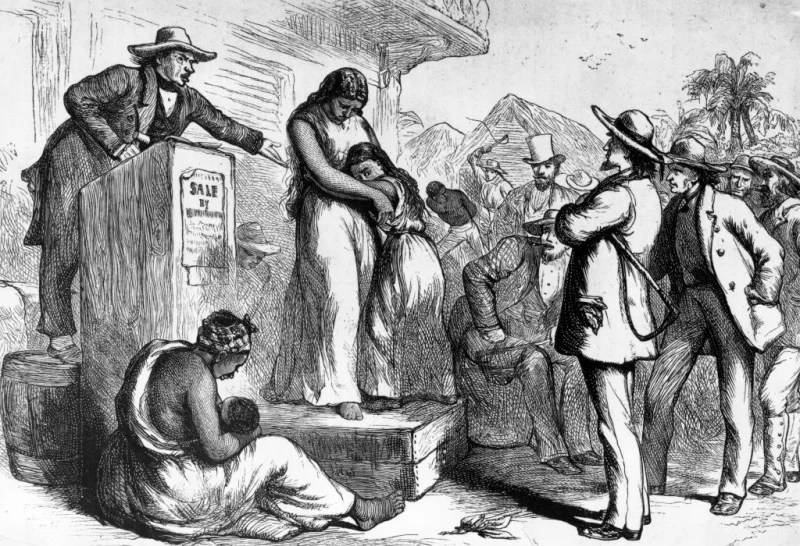
Illustration of a slave auction in America, 1830
In the Near East & the Mediterranean
- In the 18th century BCE, the Code of Hammurabi followed by Babylonians contained details on the existence of enslaved people as a part of an individual’s property. It also indicated that surgeons during those times may receive punishments for operating on enslaved people or free men.
- By the 7th century BCE, the ancient civilisation of Greece provided details on the role of enslaved people in their society. The states of Sparta and Athens were known to be highly dependent on forced labour. In Sparta, slavery was described as serfdom and were mostly conquered people who worked for Spartan enslavers, but most rights were retained as they still lived on their own land.
- In contrary to Spartan serfs, enslaved people in Athens possess no conventional rights. Most were domestic servants and some as miners. Few were owned directly by the state, such as the archers from Scythia who worked as police force in Athens.
- In the Roman Empire in the 2nd century CE, the emperor used enslaved people as secretarial staff who were more privileged than others. Most enslaved men engaged as gladiators or worked in mines.
- During the Middle Ages, most enslaved people were prisoners of war. The Germans in particular, captured many Slavs in their eastward expansion and named them as ‘slave’.
- At the same time, the Arabs operated a slave trade along the coastlines of Africa, specifically in the town of Zawila. Even during the time of Muhammad in the 7th century, the Qur’an mentioned that enslaved females should be treated well.
In Ancient Egypt
- For many years, some believed that the great infrastructures of ancient Egypt, like the Great Pyramid at Giza was built by enslaved foreigners. Today, many scholars argued that the pyramids were built by free Egyptians who themselves were skilled artisans.
- In ancient Egypt and other early societies, being prisoners of war was the principal cause of slavery. Enslaved males and females were used in labour. In addition to temple servants, men were at times included in the army, while women sometimes became concubines.
- Free Egyptians could be enslaved due to committing unlawful acts. Enslaved Egyptians were stripped of freedom, along with their spouse and children’s freedom. Moreover, if an enslaved woman gave birth to a child, regardless of the status of the father, the child was born into slavery.
- Moreover, a debtor could also be enslaved in ancient Egyptian society. In addition to failure to pay debt, peasants could also sell themselves into servitude, in exchange for food and shelter.
- Unlike slavery on the African continent, there was no evidence of slave market in ancient Egypt. Scholars believe that individual slave dealers did personal transactions as proven by commercial documents.
- Enslaved people were also acquired through inheritance and religious endowments.
Slavery to serfdom in Europe
- At the time before the Roman Empire collapsed, hereditary agricultural enslaved people had similar status to free tenant farmers. Through time, enslaved people became serfs who followed laws along with lands they worked on. By the Middle Ages, many parts of Europe, particularly in England, slavery was replaced with serfdom which became the foundation of feudalism until the Great Peasant Revolt in 1381. In France, serfdom came to an end during the revolution in 1789. In Russia, it was Tsar Alexander II who abolished the institution through a decree in 1861.
Slavery and slave trade in Africa
- By the 15th century, Portuguese expeditions became the first European ships to have regular contact in sub-Saharan Africa. The region of Sahara was known to be the main source of enslaved people transported to the Mediterranean. Through sea routes, the Portuguese expanded the slave trade and discovered new channels.
- In 1460, Portuguese settlers moved into the Cape Verde Islands which granted them a monopoly over slave trade. Some enslaved Africans worked in plantations of indigo and cotton in Cape Verde, while others were sold in Madeira and Seville.
- Due to the growing market for enslaved people, the coast of the African region became known as Slave Coast or Portuguese Guinea.
- With the growing market for enslaved people and agricultural prosperity of plantations of the Cape Verde Islands, enslaved Africans were then transported to the Portuguese colony of Brazil.
- By the 18th century, other European naval powers, such as Britain, showed interest in this profitable commerce.
Triangular Trade
- John Hawkins was the first Briton to engage in the slave trade in 1562, making a considerable profit transporting enslaved people from Africa to work in the Caribbean Islands. By the time the TransAtlantic trade was coming to an end in 1808, only 6 percent of enslaved Africans landing in the New World had gone to North America.
- By the mid-16th and 17th centuries, a number of British merchants began to establish charters and settlements on the west coast of Africa for gold, ivory, dyewood, and indigo.
- Due to the lucrative profits of the continent of Africa, competition between the European powers of Holland, Denmark, and Portugal grew. Rivalry further increased with the introduction of slavery.
- An estimated 10 to 12 million enslaved Africans were transported to the Americas between the 16th and 19th centuries.
- The trade crossed the Atlantic Ocean, which completed the three stages of the triangular trade. Between 1640 and 1807, the British slave trade dominated the industry.
- To aid the labour-intensive cultivation of tobacco in the Jamestown colony, about 20 enslaved Africans were purchased from Dutch privateers.
- As demand for labor intensified, the British crown expanded the slave trade in its colonies in the Americas. Through the Navigation Act of 1660, only English-owned ships were allowed to enter its colonies.
- To further expand the slave trade monopoly, Charles II had sole rights to the Company of Adventurers Trading to Africa. Overseen by James, the Duke of York, the British trade of gold, silver, and enslaved people to West Africa was monopolised.
Effects of the Transatlantic Slave Trade in African society
- Even before the TransAtlantic slave trade led by the British, enslaved Africans were initially subjected to rigid labour under the Spanish and Portuguese authorities. However, with the massive system of the slave trade by the 18th century, African societies were greatly affected.
- With warlords in control, warfare among African tribes intensified. The presence and demand for European guns destroyed African kinship.
- As a result of tribal raids and war, many experienced famine and displacement.
- In exchange for enslaved people, European goods such as cloth, iron bars, horses, pottery, guns, and brandy reached Africa.
- With the demand for enslaved people, African societies became slave-based states and economies.
- Africans could be enslaved through the following: (1) punishment for a crime, (2) payment from debt, and (3) prisoners of war.
- Destruction of societies and displacement of African people. According to estimates, about 12.5 million Africans were transported to the Americas during the Transatlantic slave trade.
- Aside from slave trading, African societies experienced depopulation with the deadly diseases brought by European slave traders. Diseases included smallpox, typhus, syphilis, and tuberculosis.
- European colonial conquest of coastal Africa further developed. Ports and trading posts were built in the modern countries of Togo, Benin, Nigeria, Congo, Angola, and Ghana.
- Rulers and slave sellers became wealthier due to the African slave trade. Amidst the abundance of money, in the long run, slave trading caused instability among African tribes.
Effects of the Transatlantic Slave Trade on Britain
- During the 18th century, Britain became known for being the first country to undergo economic industrialisation. The Industrial Revolution in Britain was initially characterised by the production of cotton mills. Cotton was directly imported from the New World, which was produced through slave labour, making it cheap. Moreover, the Americas and Africa became good export markets for European goods.
- By the 1800s, about 60% of British goods were exported to the Americas and Africa through the west coast ports of Glasgow, Liverpool, and Bristol.
- Ports and shipping industry in Britain grew.
- The slave trade gave Britain great access to cheap raw materials, which contributed to greater production of goods, thus leading to higher profit.
- About 70% of enslaved Africans worked in tobacco, cotton, and sugar plantations in the Americas.
- In order to secure overseas trading, the British Empire imposed a series of acts including the Molasses Act, Direct Export Act, and Navigation Acts.
- Another result of profits from the slave trade was the building and development of canals and railways in Britain.
- Amidst affecting the growth of the Industrial Revolution in Britain, the slave trade was not the sole factor behind such industrialisation. Many factors, including new machines and factories, greatly contributed to this process.
Slavery In American Colonies
- In 1619, the colony of Jamestown, Virginia received the first 20 enslaved Africans in America. Privateer The White Lion seized enslaved Africans from Sao Joao Bautista’s slave ship.
- By the turn of the 17th century, British colonies in North America addressed the huge demand of labour from indentured servitude of poorer Europeans to slavery of Africans.
- When white indentured servants began to leave the plantations, the labour system changed. Initially, Native Americans were forced to work on farms, however, the spread of European diseases eventually diminished their population.
- In order to meet the demand for labour, plantation owners turned to enslaved Africans. In 1750, there were about 235,000 enslaved Africans, wherein 85% lived in the South. With the expansion of the slave trade, plantation farming also grew, specifically in South Carolina and Georgia.
- Enslaved people were primarily engaged in agriculture, which was the backbone of the Southern economy working on indigo tobacco and rice plantations on the southern coast in Maryland, Virginia, and Georgia.
- Enslaved people made up a tenth of the total Southern population in 1680 and grew to a third by 1790.
- 293,000 enslaved lived in Virginia alone, making up 42% of all enslaved people in the US. Maryland, and North and South Carolina each had over 100,000 enslaved people. After the American Revolution, the South's enslaved population exploded to 1.1 million in 1810 and over 3.9 million by 1860.
- Aside from being suited to the tropical climate, enslaved Africans had skills in crop cultivation. Moreover, unlike American Indians, Africans had some immunity to tropical diseases like malaria and yellow fever. However, poor food supply and horrible working conditions contributed to their high mortality rate in the Americas, especially in the Caribbean.
- Enslaved Africans who arrived in the American colonies brought knowledge of cultivating tobacco and rice crops. Colonists knew little about cultivation.
- One of the main killers of enslaved Africans during the Middle Passage voyage was starvation and diseases like dysentery and scurvy.
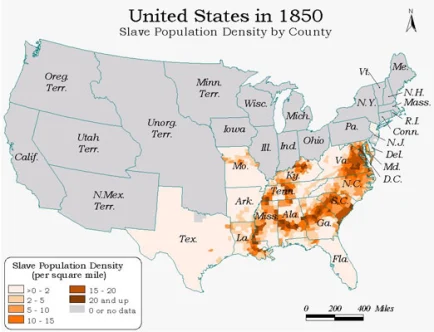
Slave population in 1850
Position of enslaved people in colonial America
- Due to relatively small populations in New England and the Middle Colonies (with only 3 to 6% slave population), slavery had minimal impact on colonial society compared to Chesapeake and South Carolina with a significant enslaved population.
- Like other colonial empires, enslaved people were at the bottom of the social hierarchy, with little to no legal rights. They were treated as property and sold in marketplaces. Aside from working hard, the lives of enslaved people were entirely dependent on their enslavers.
- Among their treatments were as follows:
- Enslavers who sexually abused enslaved people were not punished
- Beating and killing of enslaved people was not covered by the law
- Enslaved people in plantations were more overworked than those in urban areas
- Enslaved people were considered property and not people
- Even before the end of the TransAtlantic Slave trade, the South did not need a constant infusion of forced immigrants to work as enslaved people in their vast populations. This was in part due to the equal male-to-female ratio of enslaved population brought into the US in the 1730s to ‘50s which resulted in an increased birth rate among the enslaved.
- Further, the mortality rates among the enslaved population after the gruesome expedition from the home country reduced dramatically. This was because the Southern region cultivated tobacco, and after the invention of the Cotton Gin in 1793, cotton crops grew half to three-quarters of the corn crop harvested between 1840 and 1860.
- These tasks were less arduous than the work of the enslaved people in the sugar plantations of the West Indies and the mines in South America. Enslaved people in the South worked in industries, undertook domestic tasks, and grew food crops in addition to cash crops.
Evolution of slavery within the American justice system
- As the young American nation was establishing itself, political and legal thought shifted, and institutions evolved in a manner that facilitated the slave system until its eventual abolition in 1865 by the Thirteenth Amendment.
- Increasing tensions between southern and northern states over slavery and the election of Abraham Lincoln, as the 16th president of the United States, resulted in the outbreak of the Civil War.
- With the ongoing Civil War, on 1 January 1863, President Lincoln issued the Emancipation Proclamation that officially freed all enslaved people in states under rebellion. As a result of freeing 3 million enslaved Africans in the south, public opinion supporting the Union increased. Moreover, about 186,000 blacks joined the Union army, while the Confederacy was deprived of a labour force.
- The victory of the Union in 1865 granted freedom to about 4 million enslaved Africans. Later in the same year, during the Reconstruction period, the 13th Amendment was passed that officially abolished slavery.
- Following the ratification of the 13th Amendment that freed millions of enslaved Africans during the Reconstruction period, Black Codes emerged.
- The codes, or strict laws, on when, where, and how former enslaved people should be treated were the legal way for southerners to bring back the black population or free enslaved people into servitude.
- Features of the 14th & 15th Amendments
- In 1868, the U.S. Congress ratified the 14th Amendment to the Constitution that granted citizenship to all persons born in the U.S., including formerly enslaved people.
- In 1870, the 15th Amendment was ratified, which gave African-American men the right to vote. Amidst political intimation by white extremists in the south, black voters were able to place Republicans in power.

